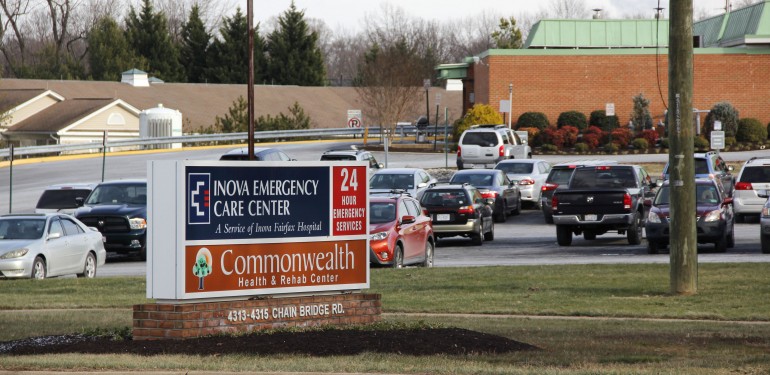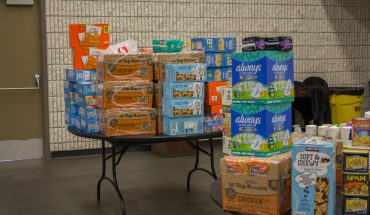(Photo credit: Amy Rose/Fourth Estate)
This story was originally published in the Feb. 1 issue of Fourth Estate.
On Dec. 22, 2015, Gov. Terry McAuliffe announced a partnership between Inova and Mason.
The partnership included Inova contributing $2.5 million in seed funding and the state contributing $16 million, according to the Washington Post. Inova’s $2.5 million will be distributed as follows: $500,000 will go toward cancer research, $500,000 will support heart disease research, $1 million will help build an Inova-Mason Proteomics Center on Inova’s Personalized Health campus and $500,000 will support the construction of the Mason-Inova Institute for Personalized Medicine Public Policy and Ethics.
The seed money will help fund initial research, which will then generate results that allow Mason “to be more competitive in applying for other research grants, from places like the National Institute of Health (NIH) … so we can embark on larger, more impactful research projects,” Mason Provost David Wu said.
Specific biomedical research projects in the areas of cancer, heart disease and metabolic disease will be conducted, as will additional research in personalized medicine and health care, according to News at Mason.
According to Wu, this partnership is a natural next step as Mason and Inova have been collaborating for over a decade.
“I’ve been working with [Vice President for Research at Inova, Dr. Younossi, and CEO of Inova’s personalized medicine campus, Todd Stottlemyer] to basically structure this agreement and, of course, with many of our faculty involved in the process,” Wu said. “Inova is strengthening and developing their research capabilities in biomedical research, and Mason has some of the important research capabilities that we can collaborate on, [and] in order for us to make important progress in this research, we need access to clinical data.”
Emanuel Petricoin, Mason professor and co-director of the Center for Applied Proteomics and Molecular Medicine (CAPMM), said that “both entities can gain a lot … and it’s a great opportunity for Mason to … work with world class clinicians at Inova and especially within the context of precision medicine initiatives … being integrated into clinics as much as possible.”
According to Petricoin and Wu, Mason researchers are responsible for some of most cutting-edge precision medicine trials in the world.
Petricoin explained that CAPMM has developed a distinct approach to proteomics and has invented proteomic technologies that are being used in a number of world-leading precision medicine trials. Petricoin said this partnership will advance research in proteomics, which seems to be the future of precision medicine.
“Inova has been very good at leading a genomics based analysis and now we can extend that to the next revolution which is the protein side,” said Petricoin. “The genome is the information archive but it’s the proteins that do all the work. … It’s the proteins’ that are the drug target. Drugs work by acting on and through proteins, not genes.”
The partnenship also means new opportunities for Mason students majoring in subjects like biology and health policy.
According to Wu, in the past, Inova has been an accommodating partner providing internship opportunities for students in the health sciences, including neuroscience and nursing majors. This institutional partnership will provide new opportunities, especially for students interested in research with a clinical component.
“This opens up a lot of undergraduate research opportunities, because when we have a larger volume of research collaborations going on, and a lot of these research projects will then involve the faculty, graduate students, and then provide opportunities for undergraduate students,” Wu said.
Additionally, new opportunities will be available in non-science areas as a result of the Mason-Inova Institute for Personalized Medicine Public Policy and Ethics, according to Wu.
Regarding population health, opportunities in data analytics will also become available, and “that’s when you bring in the social sciences,” said Wu. He added that opportunities from the partnership are not limited to the biomedical field; they are much broader than that.
Sandra Simon, a biology major, thinks the partnership is great and is excited to hear about future discoveries.
“The partnership will help students to widen their opportunities, and it helps to cement Mason as a research university,” Simon said.
Ali Weinstein, associate professor of global and community health, interim director of the Center for Study of Chronic Illness and Disability and the graduate programs coordinator for GCH, said, “Only good things can come from organizations collaborating together.”
Weinstein has extensive experience working with Inova, and students in the HHS 492 Clinical Research Internship class have been able to work with Inova in the past without difficulty.
“I’ve been here since 2007 and have almost immediately been collaborating with Inova. I work on chronic illness, so having a partnership with a healthcare organization is almost essential to my work,” Weinstein said.
Additionally, Weinstein has had students intern at Inova every semester and has never had any difficulty arranging it.
In addition to the internships, this official partnership will open up more opportunities to other students and faculty at Mason, according to Weinstein.
“It was easy for us to get this class going and for us to do this collaboration because we had a great collaborator at Inova, and Dr. Gerber has a natural link. We were on the lucky side, and perhaps this partnership will let other people not have to be lucky,” Weinstein said.
Weinstein added that this partnership might spark an interest in students who were unaware that interning at Inova was a possibility.
This partnership could have the potential to lead to the construction of a medical school operated by Inova and Mason, according to Wu.
“It’s always a possibility down the road,” Wu said. “It is a favorable pathway towards a medical school, and there are examples of how that was done, for example, Virginia Tech and Carilion Hospital. That’s kind of how their partnership started, [but] at this point we are mostly focusing on the research partnership.”




